This list of the 22 best cold water fish is perfect to get your new or existing cold water tank stocked! Not only does this article list these fish but it also gives you background into their care requirements to help you have the most success.

Keeping cold-water aquarium fish takes heating out of the equation, however, some people tend to oversimplify it.
You should not allow for violent water temperature fluctuations as stability is key to a healthy immune system in fish.
Looking after small fish species that thrive in cool water and don’t need a heater may sound tempting, but it is not a guarantee for a maintenance-free tank.
Having said that, a careful selection can definitely include such fish as well as adaptive tropical ones that do well in subtropical freshwater aquariums.
Let’s take a look at the 18 best cold-water fish, with the main focus on the hardy ones that will do well without an aquarium heater.
The Top 22 Cold Water Fish for an Unheated Freshwater Aquarium
Aquarium fish are cold-blooded creatures and the thermal environment they live in plays a significant role in their well-being and development. It’s important to understand, however, that water temperature is not the only key factor for successful fish keeping.
For this reason, I will highlight the major characteristics you should know about each fish, based on my personal experience or feedback from others who have kept them.
Here are the 22 best cold water fish that you may keep in a subtropical freshwater aquarium:
1. American Flagfish — Jordanella floridae

| Suggested Water Temperature: | 67 – 75°F (19.5 – 24°C) |
| Maximum Size: | 2.2 inches (5.5 centimeters) |
| Suggested Tank Size: | 10 or more gallons for a single specimen |
The American Flagfish, unlike many of its Killifish family members who are exceptionally tropical, is a less popular, yet excellent cold water aquarium fish. It thrives in cool subtropical water conditions and doesn’t need a heater in its aquarium. In fact, American Flagfish can be kept in an unheated fish tank as long as the temperature in the room does not fall below 20°C or 68°F.
The American Flagfish, also known as the Florida flagfish, is a member of the Jordanella genus.
Anyway, the color patterns that resemble the American flag are actually typical for males and are more conspicuous during the breeding period when they compete for female attention.
Because they’re algae grazers the American Flagfish is also one of the best algae-eating pet fish for maintaining clean cold water fish tanks.
Since they enjoy a plant-based diet, they are also known to nip other plants in the fish tank, although it is not their established habit.
I suspect this happens when the tank runs out of the algae, in which case you should feed them on algae tablets to help them deal with their “addiction”. American Flagfish are usually peaceful and can live in a social community tank, however, do make sure that the tank’s volume is spacious enough for them.
A perfect habitat for the American Flagfish would be a densely planted fish tank with lots of hiding places such as caves, driftwoods, etc.
Author’s Note: Check out our post on The American Flagfish (Jordanella floridae), A Patriotic Beauty for Freshwater Aquariums!
2. Odessa Barb — Pethia padamya

| Suggested Water Temperature: | 59 – 80°F (15 – 26.6°C) |
| Maximum Size: | Typically between 3.5 and 4 inches (8.9 to 10.1 cm) |
| Suggested Tank Size: | 55-gallon tank because they should be kept in groups |
No cold water fish would be full without the super hardy Odessa Barb.
The Odessa Barbs belong to the Pethia genus which includes currently 39 species.
Odessa Barbs thrive in subtropical temperatures and are therefore an ideal candidate for unheated community aquariums. These fish will do fine in a wide range of temperatures, namely between 59 and 80°F or 15 to 26.6°C.
Aside from their temperature tolerance, the Odessa Barbs also have no problem with various pH levels.
They have an excellent ability to adapt to water acidity in the range of 6.5 and 8.0.
Although extremely hardy, I would not say that keeping Odessa Barb doesn’t have its caveats.
For example, these fish are semi-aggressive and will likely nip at long-finned tank mates, unless in large groups of their own.
The Odessa Barb is a schooling fish and in my experience does well in groups of at least 8 to 10 specimens.
For this reason, I recommend getting these fish if you plan to have a medium-sized tank that doesn’t have a heater.
The Odessa Barbs really enjoy a heavily planted tank, so I would provide them with some subtropical aquatic plants. The Java Fern is one such plant and you can check its profile and care guide by visiting this link.
3. Scarlet Badis — Dario dario

| Suggested Water Temperature: | 68 – 78.8°F (20 – 26°C) |
| Maximum Size: | Close to 1 inch, but usually around 0.8 inches (2 cm) |
| Suggested Tank Size: | 10 gallons for 1 male and 4 females specimens |
If you’d like to look after small cold-water fish species that do well in nano aquariums then you can give the Scarlet Badis fish a try. They barely grow beyond 1 inch and usually mature specimens remain at 0.8 inches or 2 centimeters in body length.
The Scarlet Badis are among the only six species in the Dario genus.
Along with being tiny and visually appealing, Scarlet Badis fish have a peaceful, timid temperament.
As they may get easily intimidated by larger tank mates, these nano fish should be kept along with other small community fish or, better yet, in a single-species aquarium.
The Scarlet Badis are not an easy cold-water fish to keep as you need to diligently maintain their diet and water parameters.
Do not underestimate these subtropical pet fish due to their timidity or small size, because they happen to be micro-predators.
Any prey that fits their mouths is heartily welcomed. However, they are not full-time hunters, as they are actually omnivores.
Anyway, if you are somewhat experienced in the hobby, Scarlet Badis are an excellent choice for a micro fish that thrives in unheated water.
Scarlet Badis fish will appreciate a heavily planted and decorated aquarium that provides cover whenever they feel intimidated. Rocks and driftwood can do, though they especially like caves.
4. Dracula Minnow — Danionella Dracula

| Suggested Water Temperature: | between 66 and 78.8°F (19 to 26°C) |
| Maximum Size: | the maximum ever recorded was 0.65 inches (1.67 cm) |
| Suggested Tank Size: | 5+ gallons for a school of 10 specimens |
The Dracula Minnow is another small, cold-water fish that can be kept without a heater, because of their preference for water with room temperatures. They are adaptive and will thrive in water temperatures of between 66 and 79°F or 19 to 26°C.
This little fish comes from the small Danionella genus, the species of which lack scales on their bodies.
Anyway, Dracula Minnows are a social subtropical fish species and can be kept in community cold water fish tanks with other micro fish.
Related: Best Freshwater Fish & Invertebrates for a Small 5-Gallon Tank
However, I found that they will also do great in single-species biotope aquariums.
Far from sulking and looking withdrawn as some odd-looking people do, this fish is relatively active and enjoys schooling.
If you are thinking of keeping nano fish breeds that would rather school in room temperature water, enlist the Dracula Minnow as a possible option.
Bear in mind, that it may be difficult to find them in the fish store.
5. Endler’s Livebearers — Poecilia wingei
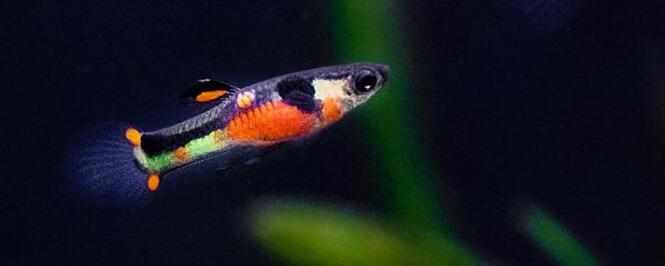
| Suggested Water Temperature: | 65 to 80°F (18.3 to 26.6°C) |
| Maximum Size: | 1.8 inches (4.5 cm) |
| Suggested Tank Size: | 10+ Gallons |
Endler’s Livebearer are undoubtedly one of the best freshwater fish for a beginner who is just starting in the fish-keeping hobby because they are easy to care for, and hardy. Endlers are also attractive and do not grow more than 2 inches.
The Endler’s Livebearers are members of the large and widespread Poecilia genus.
Endler’s livebearers can tolerate a wide range of water temperatures and are an excellent choice as small pet fish that don’t really need an aquarium heater to feel at home.
They remain small even in adulthood, measuring not more than 1.8 inches for females and barely 1 inch for males.
An aquarium as small as 10 gallons can accommodate them, though you can go for a larger one to make them feel more comfortable should you opt to keep a large group.
At times the best way to keep them is in their own fish tanks.
If you are indeed a beginner, you should know that Endler’s Livebearers are hard to distinguish from guppies, and only seasoned hobbyists can quickly tell which is which.
The two species usually crossbreed if kept in one and the same fish tank. For this reason, avoid mixing them if you do not want their hybrid offspring.
Endlers are happier in a planted aquarium with lots of hiding places.
When the happiness is too much, they do jump out so make sure the aquarium has a lid on it.
Author’s Note: Check out our post on The Vibrant Endler Guppy Fish for A complete care guide!
6. Glowlight Danio — Danio choprai
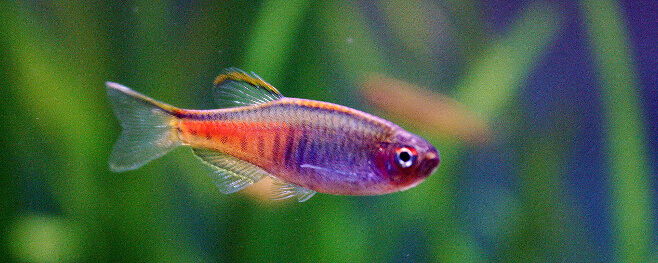
| Suggested Water Temperature: | 19 – 24°C (67 – 76°F) |
| Maximum Size: | 1.1 inches which equals 2.8 cm |
| Suggested Tank Size: | 20 gallons long and other lengthy tanks |
The Glowlight Danio is another small freshwater pet fish that enjoys cool aquarium water. A beginner can handle the care for this fish because it easily adapts to water changes with little to no issues. Glowlight Danios are extremely tolerant to temperature fluctuations, which makes them ideal for unheated tanks.
This freshwater fish is from the Danio genus, native to South and Southeast Asia.
Bear in mind, however, that as with all Danio species, the Glowlight Danio prefers its water on the cooler side as it will not handle tropical temperatures very well. Moreover, GL Danios eat just anything floating at the water surface, since they are omnivores.
Make sure, however, that their aquarium water is always clean.
That calls for changing up to 20% of the water every week.
The Glowlight Danio is an active fish, especially when in a group of not less than 6 companions.
These tiny, slender, fish will do best in a subtropical fish tank where they will school together, showing off their radiant colors of orange, gold, turquoise, and green.
As with all Danios, being active sometimes involves jumping out of their home aquarium.
Though super active, these fish are shy and peaceful so avoid housing them with aggressive tank mates and provide them with floating plants for security.
Glowlight Danios resemble the Zebra Danio fish to some extent (one of their cousins) so do not confuse them in the pet store or simply order them from a live fish supply store online.
7. Variatus Platy — Xiphophorus variatus
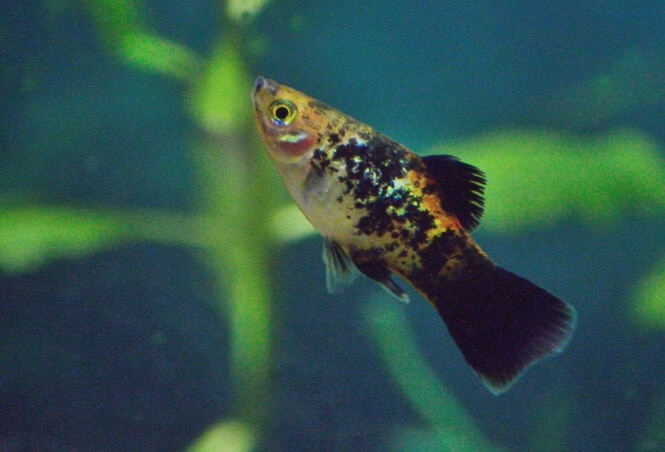
| Suggested Water Temperature: | 64 to 80°F (18 – 27°C) as these fish are highly adaptable |
| Maximum Size: | up to 2.5″ or 6.4 cm |
| Suggested Tank Size: | 10 gallons for 2 specimens and 20 gallons or more for 3 to 5 specimens |
The Variatus Platy is a species within the Xiphophorus genus, which inhabits Mexican and northern Central American waters.
Variatus Platies happens to be some of the best cold-water fish I can recommend for beginners because they are hardy and not so picky about water parameters. Apart from the fact that they can be kept without a heater, they are also peaceful enough to get along with all fish species with a similar temperament. This naturally makes them an excellent fit for community tank setups.
Another quality that makes the Variatus Platy a good subtropical fish for a beginner hobbyist is that it will eat almost all offered foods.
These fish might also eat soft algae but don’t expect them to work well as an algae eater.
Still, get them a reasonably sizable aquarium with ample swimming space.
Include live aquatic plants as well but mind that you need to limit driftwood because it may affect the water’s acidity a little too much.
Variatus Platies are livebearers meaning they won’t do well in acidic water.
8. Red Shiner — Cyprinella lutrensis

| Suggested Water Temperature: | prefers between 57 and 75°F (14 to 24°C) but can tolerate a very wide range of water temperatures |
| Maximum Size: | 3.5 inches or 9 centimeters |
| Suggested Tank Size: | 40 gallons Breeder, or other tanks with 36″ of length as a minimum |
Red Shiners are natives of the U.S. and are extremely adaptable – they tolerate both very low (57°F) and very high (95°F) temperatures. Some hobbyists even manage to keep them in outdoor ponds during winter with no ill effects. However, they are mainly classified as cold-water fish because they prefer cool environments.
The Red Shiners or the satinfin shiners, as they have been known, belong to the Cyprinella genus.
They suit a community tank with other fast-swimming fish that prefer cooler waters as long as the tank-mates are not too small to fit their mouths.
Red shiners are schooling fish and mainly occupy the middle of the water column in an aquarium.
They eat both plants and flesh and on some occasions – algae.
These qualities make the red Shiner fish beginner-friendly in terms of care level as they are very easy to look after in an unheated aquarium.
The only thing that’s recommended to have in a cool water aquarium with Red Shiners is an aerator because they feel better in a well-oxygenated environment.
The males develop pink, blue, or purple sides during the breeding period, which makes them a very attractive cool water fish.
9. White Cloud Mountain Minnow — Tanichthys albonubes

| Suggested Water Temperature: | 59 to 71°F (15 to 22°C) |
| Maximum Size: | 1.4 inches (3.6 cm) |
| Suggested Tank Size: | 10 gallons at the minimum for a school of 5 to 6 specimens |
Coming from the Tanichthys genus distributed in China and Vietnam, the White Cloud Mountain Minnows are almost extinct in their native habitat.
The White Cloud Mountain Minnows are some of the best cold-water fish for pets for beginners without any experience in unheated aquarium setups. In their natural habitat, they put up with temperatures as low as 41°F (5°C). However, you should keep them in a fish tank with a temperature between 59 and 71°F (15 to 22°C) if you want to see them thrive.
Another reason WCMM fish suit a beginner is that they don’t take long to acclimatize to different aquarium conditions.
White Cloud Mountain Minnows are also good candidates for subtropical community tanks with nano fish because they belong in the dwarf fish category, measuring a maximum of 1.4 inches when fully grown.
Anyway, they have beautiful coloration, which comes out better against a dark substrate and in a heavily planted tank.
They feed mostly on flakes, shrimps, insect larvae, or the insects themselves.
Author’s Note: Check out our post on The White Cloud Mountain Minnow for an insightful fish profile on this majestic beauty.
10. Rainbow Shiner — Notropis chrosomus

| Suggested Water Temperature: | 11 to 21°C (51.8 to 69.8°F) |
| Maximum Size: | 3.1 inches (8 centimeters) |
| Suggested Tank Size: | at least 40 gallons for a school of six, but preferably larger |
The Rainbow Shiners are hardy cold-water fish who can tolerate aquarium temperatures as low as 50°F (10°C).
These freshwater fish are members of the second-largest fish genus in North America named Notropis.
They suit a community fish tank because they are very peaceful among each other and with others, especially if kept in a sizable group of 6+.
Make sure the male-to-female ratio is balanced.
The aquarium should also be spacious to provide room for schooling.
Rainbow Shiners like fast currents since they originate from fast-flowing springs, rivers, etc.
They are nicknamed Drift Feeders because they like feeding on the tiny plant particles or invertebrates drifting past in the water.
This becomes a challenge when you’re breeding them because, being egg-scatterers, Rainbow Shiners end up eating their own eggs along with the other drifting food.
They are newcomers in the aquarium society so their price may still be on the higher side.
11. Rubber Lip Pleco — Chaetostoma formosae
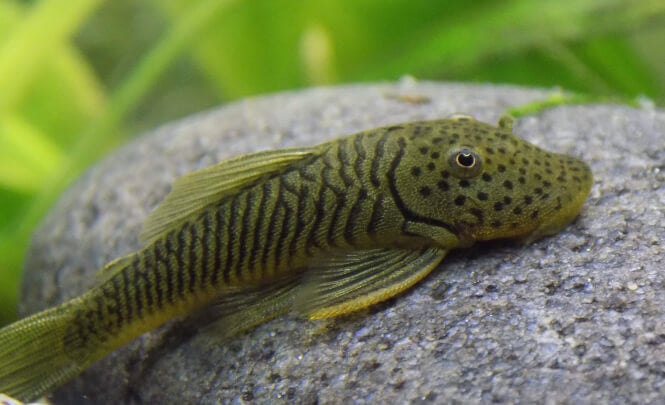
| Suggested Water Temperature: | 71 to 78°F (21.5 to 25.5°C) |
| Maximum Size: | 4.2 inches but very rarely this species may reach 4.5 inches (10.6 to 11.4 centimeters) |
| Suggested Tank Size: | 20 gallons long and above |
Also known as Blonde Bulldog Pleco, stripped Rubbernose Pleco or Chaetostoma sp. L444, the Rubber lipped pleco remains one of the best cold-water fish to clean a tank from any type of algae. Rubber lip plecos are full-time algae-eaters and a single one can exterminate all the algae in a 20-gallon fish tank within less than 2 weeks.
The Rubber Lip Pleco comes from the Chaetostoma genus, most of the species of which inhabit fast-flowing mountain waters in the lower Andes.
Note that the water temperature in the aquarium should not drop much below 22 degrees, though this fish will tolerate lower temperatures on occasion.
Anyway, not many aquarists are familiar with the Rubber Lips Pleco when it comes to algae demolition so it is not as yet popular as I believe it should be. I use them in my fish tank to serve that purpose.
They eat all the freshwater varieties, including the black beard algae, and brown diatom algae, which are some of the most stubborn algae species.
Therefore, if you own a subtropical fish tank without a heater and it has algae issues you can invite an RL Pleco for dinner.
Rubber Lip Plecos are best kept in an unheated aquarium because they generally prefer colder, subtropical water temperatures, especially with a current.
You can keep them in the lower end of tropical water temperatures as well, so long as there’s an acclimatization period.
They are also bottom-dwellers where you will see them scavenging peacefully.
However, their peaceful nature is at times conditional, like when you include catfish in the same community tank.
12. Meteor Minnow — Tanichthys albonubes

| Suggested Water Temperature: | 59 to 71°F (15 to 22°C) |
| Maximum Size: | 1.4 inches (3.6 centimeters) |
| Suggested Tank Size: | 10 gallons minimum but preferably larger |
The Meteor Minnow from the Tanichthys genus is the long-finned version of the White Cloud Minnow, which we have already tackled here.
However, I think Meteor Minnows look overall better and I never see them suggested for cold water aquariums.
Like their cousin, they are reasonably easy to care for and can also thrive in a fish tank with no heater.
Unfortunately, I’ve realized the Meteor Minnow is no longer common in fish stores as it used to be when it just came to the scene.
I’m not an expert on them, but I know that Meteor Minnows eat very little food so make sure you give them high-quality offerings, supposing this is true.
13. Bristlenose Pleco — Ancistrus cirrhosus

| Suggested Water Temperature: | 65 – 79 °F (18.3 – 26 °C) |
| Maximum Size: | up to 6 inches over many years as they are slow growers (15.2 centimeters) |
| Suggested Tank Size: | 30+ gallons |
The Bristlenose Pleco is an excellent cleaning fish that can live in a cold water aquarium. You can keep them to control the algae growth in your unheated fish tank because that’s a main part of their diet in the wild.
The Bristlenose Pleco belongs to the Ancistrus genus, the species of which prefer flowing water in the wild. It’s quite amazing that this fish is one of the pleco species that remain relatively small even after eating a ton of algae.
Related: Full-Grown Sizes of the Most Popular Plecos
Anyway, you can also learn more about the best algae eaters for home aquariums in my article over here. Bristlenose Plecos are beautiful and as age catches up with them, they develop tentacles that resemble a mustache, adding to their exotic look.
I have seen at least two varieties of them: the albino and the long-finned types.
Bristlenose Plecos are bottom-feeder fish so try not to keep another bottom-feeder with them in the same aquarium.
This way you’ll avoid encouraging conflicts over territory.
Author’s Note: Check out our post on Bristlenose Plecos (Ancistrus Cirrhosus), the ultimate algae cleaners for your aquarium.
14. Gulf Coast Pygmy Sunfish — Elassoma gilberti

| Suggested Water Temperature: | between 68 and 74.3°F (between 20 and 23.5°C) |
| Maximum Size: | 1 inch (2.54 cm), though they usually remain at 0.98 inches (2.48 cm) |
| Suggested Tank Size: | 5+ gallons |
The Gulf Coast Pygmy Sunfish is a rather unpopular cold water species of nano fish that can be kept in a small aquarium without a heater. It is not bothered by lower oxygen levels and seamlessly adapts to a wide range of water conditions, which makes caring for it easy.
The name of the Elassoma genus comes from Greek words – “elasson” meaning smaller and “soma” meaning body.
Of the seven Elassoma species, the Gulf Coast Pygmy Sunfish is the smallest with a maximum size of a fully-grown specimen of 1 inch. I’ve even listed it in my post on the smallest freshwater aquarium fish, which you can visit by clicking here.
A calm, heavily planted tank is a good idea if you want to see your Gulf Coast Pygmy Sunfish thrive, as such an environment mimics its natural habitat where the vegetation is dense and the waters flow gently.
These nano fish have a lovely appearance as they develop electric black and blue colorations.
The dominant males stand out more when marking their territories.
The coloration is most pronounced during the mating season when the males compete for the attention of the females.
Feed yours with insects and micro-worms.
Wondering what heater size fits your tank best? Check out this guide for aquarium heater sizing.
15. Least killifish — Heterandria formosa
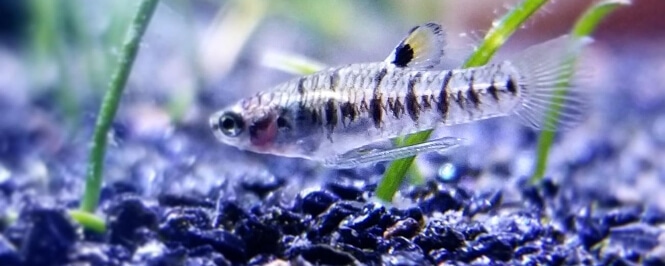
| Suggested Water Temperature: | 68 to 78°F (20 to 25.5°C) |
| Maximum Size: | 1.2 inches (3 cm) at times, but on average they are around 0.8 inches (2 cm) |
| Suggested Tank Size: | 5 gallons at least |
Contrary to your assumption, Least Killifish is not a member of the Killifish family.
The Least Killifish are cool water nano fish that remain small in their mature life.
Although tiny, the Least Killifish is a livebearer, holding the record as the smallest known livebearer with a full-grown size of 0.8 inches (2 cm) for the males and 1.3 inches (3.3 cm) for the females.
The Least killifish and two more species are the only members of the Heterandria genus.
The interesting bit here is that while other livebearers give birth all at once, a female Least Killifish drops her offsprings sparingly for days.
It can deliver three fry each day for 5 to 10 consecutive days.
Another amazing or rather amusing fact is that although the Least Killifish is so tiny, her fry is bigger than other livebearers’ fry.
So the Least Killifish is not always the least on every list.
Last but not least, caring for Least Killifish is easy because they readily get used to different water conditions.
16. Celestial Pearl Danio — Danio margaritatus
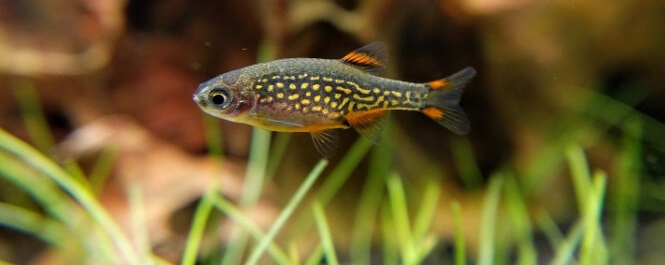
| Suggested Water Temperature: | between 71 and 78°F (21.6 to 25.5°C) |
| Maximum Size: | Close to 1 inch (2.5 cm) |
| Suggested Tank Size: | 10+ gallons for a school of 6 to 7 |
Celestial Pearl Danios, also known as Galaxy Rasboras, are a reasonable choice for small subtropical freshwater fish that do not require a heater in their aquarium. Celestial Pearl Danios grow up to 1 inch in body length and enjoy a water temperature of 71°F to 78°F (21.6°C – 25.5°C).
Years ago, scientists described the Celestial Pearl Danio as a member of the genus named Celestichthys and was believed to be a rasbora.
Later, a more comprehensive study proved that this species belongs to the Danio genus. I’ve been so impressed with this fish’s beauty that I included it on a compilation I did on the most colorful and pretty freshwater fish for aquariums.
A 10-gallon tank can do because these fish are relatively tiny.
They like moderate light, which you can achieve by adding plants.
The plants also give them some cover (which they really need by the way, since they are quite timid).
Author’s note: If you want to check other fish ideas for a 10-gallon aquarium, that are not limited to coldwater fish – click here!
17. Zebra Danio – Danio rerio
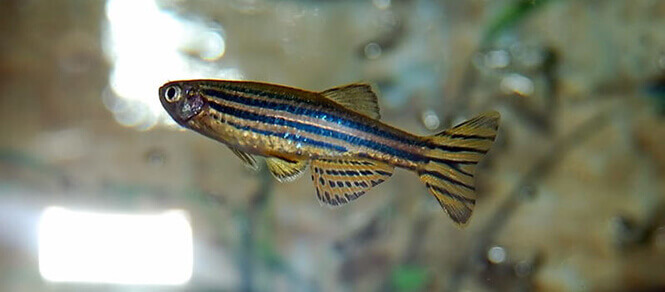
| Suggested Water Temperature: | 64 to 76°F (17 to 25°C) |
| Maximum Size: | 2.2 inches (5.6 cm) |
| Suggested Tank Size: | 20 gallons LONG for a school of 7 to 8 specimens |
The Zebra Danio suits a beginner because it is easy to take care of thanks to its hardiness and high adaptiveness.
The Zebra Danio, same as the Glowlight Danio and Celestial Pearl Danio, comes from the Danio genus.
In fact, I’ve included it in my list of the easiest aquarium fish to look after, which you can check out by clicking this link. The demeanor I like the most about the Zebra Danio is that it is rather friendly, and so does well in a community fish tank.
I’ve observed them letting other same-temperament fish species school with them in the middle and upper water column.
As a subtropical schooling fish species that thrives in aquariums with cool water you do not need a heater to keep Zebra Danios. They can be kept in aquariums with room temperature water as long as there are no violent fluctuations in the temperatures between day and night.
Zebra Danios do not mind strong water currents and actually enjoy swimming in those.
Zebra Danios need long horizontal space because they are very active swimmers, so the absolute minimum for an aquarium for them would be the long version of a 20-gallon one.
18. Paradise Fish — Macropodus opercularis
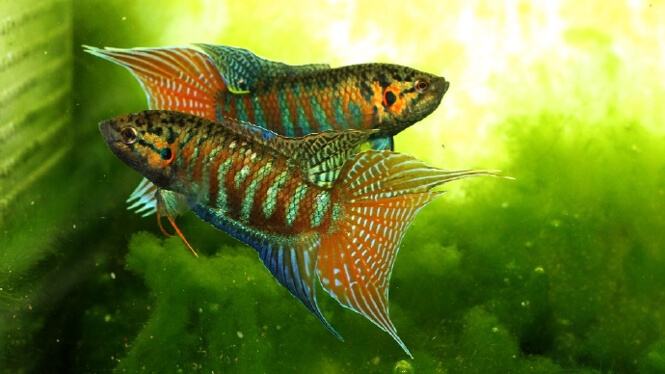
| Suggested Water Temperature: | 61 to 75°F (16 to 24°C) |
| Maximum Size: | 4 inches (about 10 centimeters) |
| Suggested Tank Size: | 20 gallons for a single specimen, and 30 or more for a small group |
The Paradise Fish, also known as a Paradise Gourami, from the Macropodus genus is one of the members forming the Gourami family.
Paradise Fish are an excellent choice for freshwater pet fish that appreciate a cold water aquarium though they can also adjust to warmer water, as they are able to adapt to a wide range of temperatures.
The Paradise Gourami is arguably one of the most colorful fish one can keep in their freshwater aquarium.
There are not many fish with bright colors such as the Paradise Fish in the aquarium hobby (visit the link to see 30+ species that I have found). They also tolerate low-oxygen environments, because they have the ability to suck in oxygen directly from the air just like a Betta fish.
This is done through a unique respiratory organ called a labyrinth.
These fish will eat any food, though they mostly enjoy meaty meals like brine shrimp and worms.
Paradise Fish mostly fight one another but if housed with fish that cannot fend for themselves there may be other casualties.
All of this calls for a sizable planted community aquarium (20+ gallons minimum) so that other timid fish have their personal space.
It is better to go for less nervous tank-mates like large tetras, giant danios, or some of the larger Plecostomus species.
Paradise Fish tend to be less aggressive when they realize that there are equally bold or bigger tank-mates in the aquarium.
Interestingly, these fish are intelligent and some hobbyists teach them tricks.
The Paradise Fish has the ability to learn, which is not common with many aquarium fish.
Anyway, it is best to try looking after this firebrand cold-water fish species if you’re not new to the hobby and have experience with keeping aggressive aquarium pet fish.
19. Hillstream Loach – Beaufortia kweichowensis

| Suggested Water Temperature: | 68 to 80°F (20 to 26.6°C) |
| Maximum Size: | up to 3 inches (around 7 cm) |
| Suggested Tank Size: | 55 gallons for a school of 3 to 4 fish |
Hillstream loaches (Beaufortia kweichowensis) are nothing short of bizarre in terms of looks.
Their suction cup fins and flattened body, make them seem like something that’s come out of a Ridley Scott movie.
And sure enough, that’s why they’re so appealing to many aquarists.
Who wouldn’t want to have a tiny alien lurking in their tank, right?
Anyways, hillstream loaches come from fast flowing rivers and currents, which are highly oxygenated. Due to this, they require a spacious aquarium with plenty of oxygen.
So to keep them safe and sound, you’ll need to provide hillstream loaches with at least 55 gallons of free space.
Additionally, you might also use an airstone or powerhead to further increase the oxygenation in your tank.
You’ll also want to keep your hillstream loaches under a tight lid, since they’ll climb all over your aquarium.
If they ever go missing, the first place you should look is the aquarium filter.
These tiny aliens are adventurous by nature and won’t miss a chance to go “surfing” in your HOB filter.
Apart from their bizarre looks, hillstream loaches are also beloved for their proclivity to eat algae.
This includes hair algae, brown diatom algae, and even black beard algae.
However, you shouldn’t expect them to survive solely on the algae in your aquarium.
If you want to keep them long-term you’ll ideally feed them with repashy gel food and sinking wafers.
Even though hillstream loaches can be kept in warm water, they will experience poor health in temperatures above 80°F.
Author’s Note: Check out our post on The Hillstream Loach, the graceful river dweller for your aquarium.
20. Clown Killifish – Epiplatys annulatus
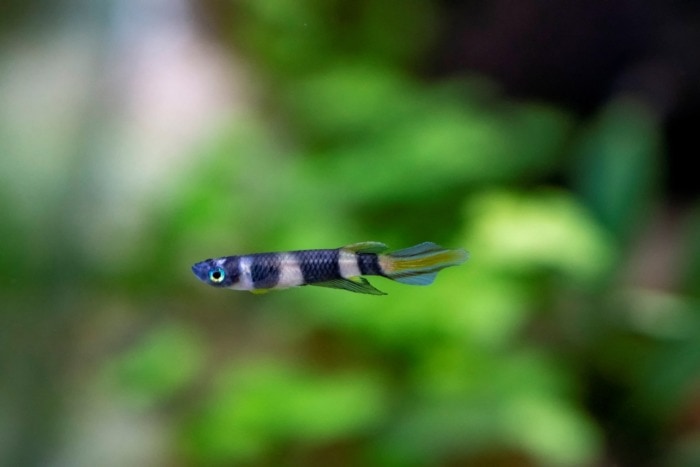
| Suggested Water Temperature: | 67 to 80°F (19.4 to 26.6°C) |
| Maximum Size: | 1.4 in (3.6 cm) |
| Suggested Tank Size: | 5 gallons |
The Clown Killifish from the Epiplatys genus is a tiny dither fish that’s a great choice for cold water nano tanks.
It grows to just 1.4 inches and can be kept in no more than 5 gallons of water.
Size however, isn’t what makes these fish unique.
It’s their looks.
With their colorful body and gorgeous, spearhead tail, Clown Killifish are arguably one of the most beautiful nano fish in the trade of coldwater species.
The tail in males has an orange stripe with two red lines on both of its sides.
Females lack tail coloration but are equally magnificent nevertheless.
And even though you might feel tempted to fill your nano tank with male Clown Killis, it would be better not to.
Males tend to exhibit aggressive behavior towards each other when they’re in the presence of female killis.
So to avoid altercations, you should keep at least four female clown killis for every male you have.
Apart from this, clown killifish are generally peaceful and can be kept with most small and peaceful fish.
Here are some tank mate ideas:
- Corydoras Catfish
- Minnows
- Danios
- Small Barbs
- Gouramis
In the wild, clown killifish inhabit slow-moving streams and swamps, so they aren’t well adapted to swim in waters with strong currents.
Due to this, it’s best to keep them in an aquarium with a sponge filter.
You’ll also want to use a cover, since they’re avid jumpers and might try to escape their glass prison.
21. Bloodfin Tetra – Aphyocharax anisitsi
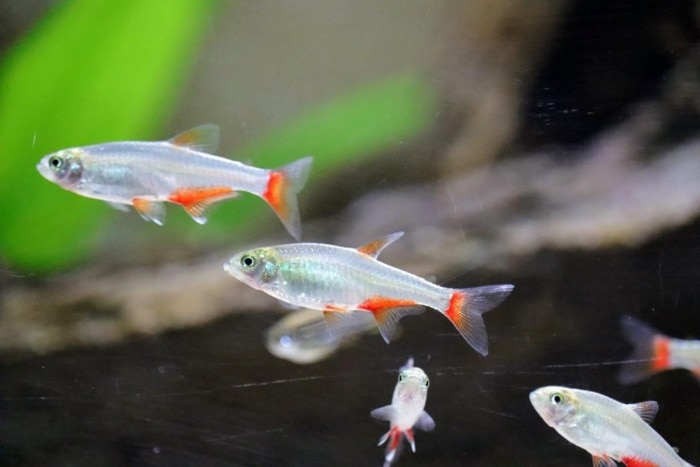
| Suggested Water Temperature: | 64 to 83°F (17.7 to 28.3°C) |
| Maximum Size: | 2.36 inches (6 cm) |
| Suggested Tank Size: | 30 gallons |
Bloodfin tetras are one of the sturdiest fish species from the Aphyocharax genus.
They can survive in both soft and extremely hard water, within a wide temperature range of 64 to 83°F.
So as long as their water parameters are kept in check, bloodfin tetras are an excellent beginner fish.
However, hardy as they might be, bloodfin tetras have a soft inner core.
It’s not unusual to see them hiding after they get introduced to a new aquarium.
You can help them overcome their shyness by keeping them in groups and using floating plants.
Bear in mind, that shy as they might be, bloodfin tetras will still nip at the fins of slower moving fish in your coldwater aquarium.
Aside from this, they’re extremely peaceful and can be housed with cories, rasboras, danios and other calm fish.
Bloodfin tetras aren’t picky eaters, so they’ll readily accept most types of fish food.
For optimal health, you should keep them on a varied diet of vegetables and insect protein.
Since they’re quite active, they’ll need to be fed roughly 2-3 times daily.
Just be mindful not to overfeed them since this can lead to a host of health issues.
22. Pepper Corydora – Corydoras paleatus
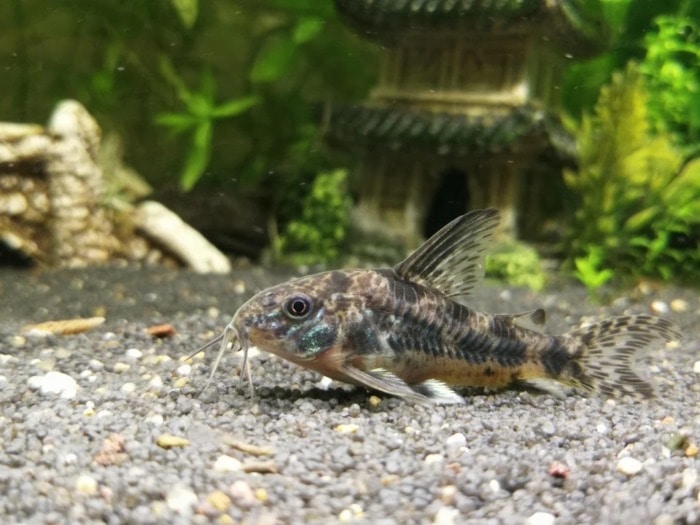
| Suggested Water Temperature: | 72 to 79°F (22 to 26°C) |
| Maximum Size: | 2.5 inches (6.4 cm) |
| Suggested Tank Size: | 20 gallons |
The Pepper Cory is one of the 175 members of the Corydoras genus and it’s brimming with charm just like the rest.
Also known as a leopard corydora, this tiny cold water fish is exceptionally hardy and can survive in low oxygen environments.
This along with its minimal care requirements make it one of the most popular fish species among beginner aquarists.
With that said, you’ll still need to provide pepper corydoras with some care as they’re not invincible (despite their hard exoskeleton).
For starters, pepper corys are schooling fish so you’ll need to keep them in groups of at least six fish.
It’s possible to have them in smaller schools, but they won’t be as lively.
Since they’re bottom dwellers, it would be best to avoid keeping them with other bottom dwelling species that might compete with them for food.
Otherwise, they’re quite peaceful and will get along with most fish species that don’t pose a threat to them.
Additionally, you’ll want to make sure the bottom of your aquarium is lined with a smooth substrate.
Pepper corydoras like to burrow in the substrate, and any sharp particles might damage their delicate whiskers.
Author’s Note: Check out our post on The Peppered Cory Catfish (Corydoras Paleatus), the speckled bottom-dweller for every aquarium!
No Heater Does Not Always Mean Low Maintenance
Keeping cold water pet fish may seem attractive but It’s important to understand that if a fish does not require a heater it does not mean it is necessarily easy to maintain.
Some uninformed people mistakenly take it to mean the fish could endure extreme neglect or the hardest conditions in an aquarium.
All aquarium fish need a certain level of care and dedication.
The point is, surviving without a heater is just one aspect of the living conditions for some fish and shouldn’t be a yardstick for determining their overall hardiness.
For instance, enduring a cold-water tank doesn’t mean the fish can also put up with poorly oxygenated conditions or unclean water.
A good example is the Hillstream Loach, which cannot thrive in polluted, low-oxygen, low-current waters.
However, they do well in cold water fish tanks.
Only go for this fish if you’re ready to put in the work to provide the optimal conditions it requires.

Always be realistic when looking after cold-water fish; don’t take it for granted they are easy to keep.
Try to Avoid Water Temperature Fluctuations
When it comes to water temperature, consistency is the key.
An aquarium fish, like many animals, can be adaptive and learn to tolerate certain conditions with time, provided they are not extreme or the change – too sudden.
Since thermal adaptation is a gradual process, constant temperature fluctuations rob pet fish of this ability to conform to the changes.
The body is soon confused and tired of adjusting back and forth to match the changes. The rapidly falling temperatures during the night could induce a cold-shock, and eventually lead to a weakened immune system in fish and, consequently, disease.
One of the most common reasons for parasitic outbreaks such as freshwater Ich in home aquariums, for example, is fluctuating water temperatures. Make sure that your unheated fish tank is not too warm in the day yet violently chilled at night.
Night and day nosedives in temperatures weaken the fish’s immunity to disease and pathogens.
My Final Thoughts
I believe I have tackled all the basics you need to understand as you consider the fish that would best work in your new cold water aquarium.
Experienced fish-keepers can keep both subtropical and tropical fish in the same tank because they have devised ways to create the middle ground in terms of temperature.
But I’d not advise a beginner to go that direction because it comes with many unnecessary complications and risks that are going to take the fun out of the hobby for someone who’s new to it.



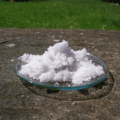


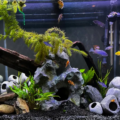
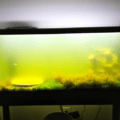
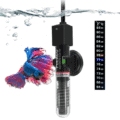

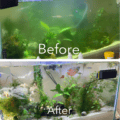

20 thoughts on “The 22 Best Cold Water Fish (OK Without an Aquarium Heater)”